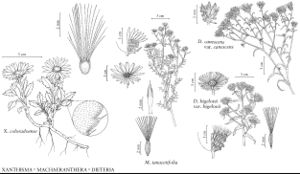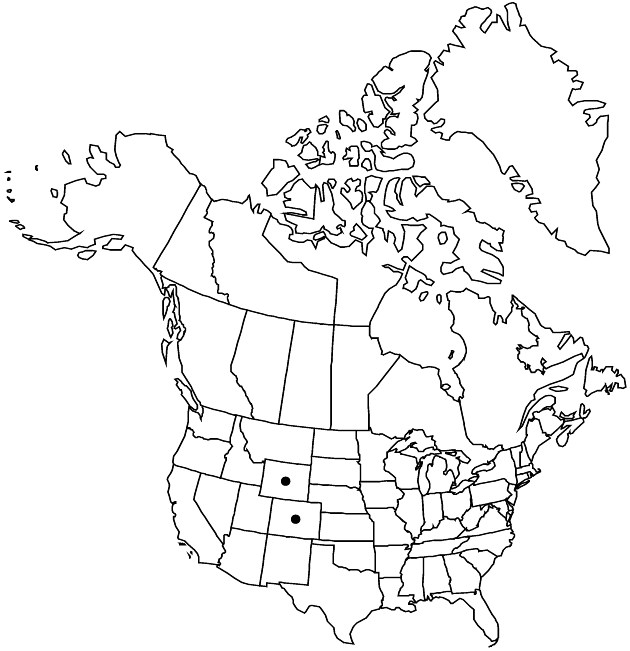Difference between revisions of "Xanthisma coloradoense"
Sida 20: 1403. 2003.
FNA>Volume Importer |
imported>Volume Importer |
||
| (6 intermediate revisions by 2 users not shown) | |||
| Line 7: | Line 7: | ||
|year=2003 | |year=2003 | ||
}} | }} | ||
| − | |basionyms={{Treatment/ID/ | + | |special_status={{Treatment/ID/Special_status |
| + | |code=F | ||
| + | |label=Illustrated | ||
| + | }}{{Treatment/ID/Special_status | ||
| + | |code=E | ||
| + | |label=Endemic | ||
| + | }} | ||
| + | |basionyms={{Treatment/ID/Basionym | ||
|name=Aster coloradoensis | |name=Aster coloradoensis | ||
|authority=A. Gray | |authority=A. Gray | ||
| + | |rank=species | ||
| + | |publication_title=Proc. Amer. Acad. Arts | ||
| + | |publication_place=11: 76. 1876 | ||
}} | }} | ||
|synonyms={{Treatment/ID/Synonym | |synonyms={{Treatment/ID/Synonym | ||
|name=Haplopappus coloradoensis | |name=Haplopappus coloradoensis | ||
|authority=(A. Gray) R. L. Hartman ex Dorn | |authority=(A. Gray) R. L. Hartman ex Dorn | ||
| − | }}{{Treatment/ID/Synonym | + | |rank=species |
| + | }} {{Treatment/ID/Synonym | ||
|name=Machaeranthera coloradoensis | |name=Machaeranthera coloradoensis | ||
|authority=(A. Gray) Osterhout | |authority=(A. Gray) Osterhout | ||
| − | }}{{Treatment/ID/Synonym | + | |rank=species |
| + | }} {{Treatment/ID/Synonym | ||
|name=Machaeranthera coloradoensis var. brandegeei | |name=Machaeranthera coloradoensis var. brandegeei | ||
|authority=(Rydberg) T. J. Watson ex R. L. Hartman | |authority=(Rydberg) T. J. Watson ex R. L. Hartman | ||
| − | }}{{Treatment/ID/Synonym | + | |rank=variety |
| + | }} {{Treatment/ID/Synonym | ||
|name=Xylorhiza brandegeei | |name=Xylorhiza brandegeei | ||
| − | |authority= | + | |authority= |
| + | |rank=species | ||
}} | }} | ||
|hierarchy=Asteraceae;Asteraceae tribe Astereae;Xanthisma;Xanthisma sect. Blepharodon;Xanthisma coloradoense | |hierarchy=Asteraceae;Asteraceae tribe Astereae;Xanthisma;Xanthisma sect. Blepharodon;Xanthisma coloradoense | ||
| Line 38: | Line 52: | ||
|elevation=2100–3700 m | |elevation=2100–3700 m | ||
|distribution=Colo.;Wyo. | |distribution=Colo.;Wyo. | ||
| − | |discussion=<p>Xanthisma coloradoense is mostly alpine, but sometimes present in foothills or on plains, scattered through the southern Rocky Mountains of Colorado and southern Wyoming.</p><!-- | + | |discussion=<p><i>Xanthisma coloradoense</i> is mostly alpine, but sometimes present in foothills or on plains, scattered through the southern Rocky Mountains of Colorado and southern Wyoming.</p><!-- |
| − | --><p>Xanthisma coloradoense and X. grindelioides var. grindelioides are known to hybridize in Carbon County, Wyoming, one of the few places where the two are sympatric. Several hybrid swarms have been detected in the vicinity of Wheatland Reservoir number 2.</p><!-- | + | --><p><i>Xanthisma coloradoense</i> and <i>X. grindelioides</i> <i></i>var.<i> grindelioides</i> are known to hybridize in Carbon County, Wyoming, one of the few places where the two are sympatric. Several hybrid swarms have been detected in the vicinity of Wheatland Reservoir number 2.</p><!-- |
| − | --><p>Two varieties of Xanthisma coloradoense were recognized by R. L. Hartman (1976, 1990). They were distinguished by size, shape, and serration of leaves, size of flowering heads, and ray corolla length. With the number of additional collections amassed, these distinctions no longer hold and the varieties are not recognized.</p> | + | --><p>Two varieties of <i>Xanthisma coloradoense</i> were recognized by R. L. Hartman (1976, 1990). They were distinguished by size, shape, and serration of leaves, size of flowering heads, and ray corolla length. With the number of additional collections amassed, these distinctions no longer hold and the varieties are not recognized.</p> |
|tables= | |tables= | ||
|references= | |references= | ||
| Line 49: | Line 63: | ||
-->{{#Taxon: | -->{{#Taxon: | ||
name=Xanthisma coloradoense | name=Xanthisma coloradoense | ||
| − | |||
|authority=(A. Gray) D. R. Morgan & R. L. Hartman | |authority=(A. Gray) D. R. Morgan & R. L. Hartman | ||
|rank=species | |rank=species | ||
| Line 63: | Line 76: | ||
|publication title=Sida | |publication title=Sida | ||
|publication year=2003 | |publication year=2003 | ||
| − | |special status= | + | |special status=Illustrated;Endemic |
| − | |source xml=https:// | + | |source xml=https://bitbucket.org/aafc-mbb/fna-data-curation/src/2e0870ddd59836b60bcf96646a41e87ea5a5943a/coarse_grained_fna_xml/V19-20-21/V20_881.xml |
|tribe=Asteraceae tribe Astereae | |tribe=Asteraceae tribe Astereae | ||
|genus=Xanthisma | |genus=Xanthisma | ||
Latest revision as of 21:06, 5 November 2020
Perennials, 2.5–14 cm; caudices branched; taproots 3–13+ cm. Stems 8–30+, simple, moderately stout to stout, not wiry, villous to pilose. Leaves: basal persistent (similar to cauline); cauline only a few pairs clustered with basal, absent distally, blades narrowly to broadly oblanceolate or spatulate, 10–80 × 3–10 mm, margins evenly to irregularly serrate or serrulate, teeth 3–14 per side, each tipped with white bristle 0.5–2 mm, faces sparsely to moderately hairy. Heads 1. Peduncles moderately to densely white-puberulent, eglandular; ebracteate. Involucres depressed-hemispheric, 5–8 × 10–25 mm. Phyllaries in 3–4 series, broadly linear to lanceolate, 2.5–13 mm, apices acute to acuminate, tipped by white seta, faces moderately puberulent. Ray florets 20–35; corollas pink to purple, tubes 2–3.5 mm, laminae 9.3–15 × 2.2–4.3 mm. Disc florets 50–150+; 4.5–6.5 mm. Cypselae narrowly obovoid to oblong, 1.7–3 mm, weakly 10–20-nerved or -ribbed, moderately to densely covered with whitish to tawny hairs; pappi whitish to tawny, 3.5–6 mm, a few abaxial bristles to 1/3 of longest. 2n = 8, 16.
Phenology: Flowering summer.
Habitat: Volcanic ash deposits, gravelly soil, limestone outcrops, mountain summits and slopes, occasionally on plains
Elevation: 2100–3700 m
Discussion
Xanthisma coloradoense is mostly alpine, but sometimes present in foothills or on plains, scattered through the southern Rocky Mountains of Colorado and southern Wyoming.
Xanthisma coloradoense and X. grindelioides var. grindelioides are known to hybridize in Carbon County, Wyoming, one of the few places where the two are sympatric. Several hybrid swarms have been detected in the vicinity of Wheatland Reservoir number 2.
Two varieties of Xanthisma coloradoense were recognized by R. L. Hartman (1976, 1990). They were distinguished by size, shape, and serration of leaves, size of flowering heads, and ray corolla length. With the number of additional collections amassed, these distinctions no longer hold and the varieties are not recognized.
Selected References
None.

